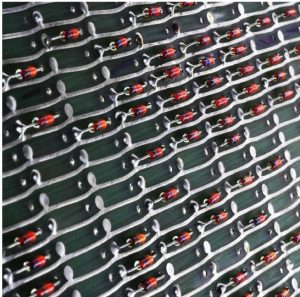History (1953): Transistors Make Fast Memories
Solid-state devices improve speed, size and reliability of memory systems.
This is a Press Release edited by StorageNewsletter.com on February 28, 2018 at 2:21 pmThis article comes from the Computer History Museum.
1953: Transistors make fast memories
Solid-state devices improve speed, size & reliability of memory systems
Diode matrix for DEC PDP-11 floppy disk boot ROM
(Courtesy Dave Fischer [www.cca.org/blog/])

The advantages of solid-state devices over vacuum tubes found application in computers, beginning in 1953 with the Manchester TC (Transistor Computer) and Bell Labs TRADIC (1954). These early designs employed discrete transistors in registers, small memory circuits that held content for immediate use by the CPU, and as drivers and sense amplifiers for magnetic core memory. Diodes also served in Read-Only Memory (ROM) arrays.
Pioneering IC manufacturers introduced flip-flops as demonstration vehicles for their first commercial offerings. Texas Instruments announced the Type 502 Binary Flip-Flop multi-chip Solid Circuit in March 1960 priced at $450 each.
A few weeks later, Fairchild fabricated the Micrologic Type F flip-flop, the first planar monolithic IC. Each chip held just one bit of memory in aerospace computers such as the AC Spark Plug MAGIC, Martin MARTAC 420, and NASA’s Apollo Guidance Computer (AGC).
As IC manufacturing costs declined with each new generation of technology, vendors developed dedicated memory devices in two basic categories: (1) Shift Register and Random Access Memory (RAM) that retain data only when power is supplied, and (2) Non-Volatile Memory (NVM) devices for applications that must retain data after power is removed. Beginning in the 1970s, microprocessors that combined logic and memory elements on the same silicon chip dramatically changed computer architecture and the nature of computing.
Memory arrays occupy more than 50% of the silicon real estate of a typical microprocessor.
By the end of the century, cost per bit had dropped sufficiently to extend the benefits of semiconductor memory technology to SSDs that emulated disk drives in industrial control and other specialized storage applications. The first high-volume laptop personal computers with flash-based SSDs entered the market in 2006.













 Subscribe to our free daily newsletter
Subscribe to our free daily newsletter

